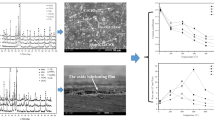The paper studies the effect of the process parameters for the production of new copper-based bearing composite materials doped with nickel and molybdenum, with CaF2 additions (DN5M3KF9) as a solid lubricant, on the structurization and tribotechnical properties at high-speed friction (bearings perform at a sliding speed of 6 m/sec and a pressure up to 38.5 MPa in air). The study focuses on the distribution of CaF2 in the composite with a Cu–Ni–Mo matrix, its role in self-lubrication of the material, and the behavior of CaF2 in the friction area under extreme operating conditions. It is shown that the solid lubricant is evenly distributed over the contact surfaces as it piles up over the entire friction area during high-speed friction. It is established that the tribofilms formed in the presence of the CaF2 solid lubricant provide high wear resistance of copper-based materials.




Similar content being viewed by others
References
D. Julthongpiput, H. S. Ahn, A. Sidorenko, et al., “Towards self-lubricated nanocoatings,” Tribol. Int., 35, 829–836 (2001).
D. Jianxin and C. Tongkun, “Self-lubricant mechanisms via the in situ formed tribofilm of sintered ceramics with CaF2 additions when sliding against hardened steel,” J. Refract. Met. Hard Mater., 25, No. 2, 189–197 (2007).
T. A. Roik, V. V. Kholyavko, Yu. Yu. Vitsuk, et al., “Influence of mechanism tribosynthesis of secondary structures for properties of antifriction composites materials based on nickel,” Met. Fiz. Nov. Tekhn., 31, 1001–1016 (2009).
I. M. Fedorchenko and L. I. Pugina, Sintered Composite Antifriction Materials [in Russian], Naukova Dumka, Kiev (1980), p. 404.
T. A. Roik, A. P. Gavrish, O. A. Gavrish, et al., Antifriction Composite Material [in Ukrainian], Ukrainian Patent No. 40139, IPC (2009), C22C9/02, C22C9/00, C22C1/00, C22C1/04, C22C1/05, Bulletin No. 6, Publ. March 25 (2009).
T. Wejrzanowski, “Computer program Micrometer,” Mater. Sci., 23, 28–34 (2005).
Acknowledgements
This study was conducted under an international agreement between the Warsaw University of Technology “Warsaw Polytechnic” and the National Technical University of Ukraine “Kiev Polytechnic Institute”.
Author information
Authors and Affiliations
Corresponding author
Additional information
Translated from Poroshkovaya Metallurgiya, Vol. 51, No. 5–6 (485), pp. 141–147, 2012.
An erratum to this article is available at http://dx.doi.org/10.1007/s11106-015-9668-9.
Rights and permissions
About this article
Cite this article
Konopka, K., Roik, T.A., Gavrish, A.P. et al. Effect of CaF2 surface layers on the friction behavior of copper-based composite. Powder Metall Met Ceram 51, 363–367 (2012). https://doi.org/10.1007/s11106-012-9441-2
Received:
Published:
Issue Date:
DOI: https://doi.org/10.1007/s11106-012-9441-2




